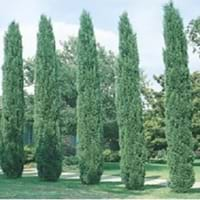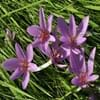Life Span
Perennial
Perennial
Type
Bulb or Corm or Tuber
Needled or Scaled Evergreen
Origin
Hybrid origin
Southern Europe, Mediterranean, Western Asia
Types
boissieri , cupanii , hungaricum , kesselringii
Moroccan cypress
South Tibet cypress
Cheng's cypress
Yunnan cypress
Saharan cypress
weeping cypress
Tibetan cypress
Mediterranean cypress
Tonkin cypress
Himalayan cypress
Vietnamese cypress
Habitat
Temperate Regions
Lowland, Mountain tops, Mountains, Terrestrial, tropical environments, Urban areas
USDA Hardiness Zone
Not Available
7-10
AHS Heat Zone
Not Available
9-3
Sunset Zone
21,22
8, 9, 10, 11, 12, 13, 14, 15, 18, 19, 20, 21
Habit
Clump-Forming
Narrow Upright/Fastigiate
Flower Color
Purple, Violet
Non Flowering Plant
Flower Color Modifier
Bicolor
Bicolor
Fruit Color
Not Available
Non Fruiting Plant
Leaf Color in Spring
Green
Dark Green
Leaf Color in Summer
Light Green
Dark Green
Leaf Color in Fall
Several shades of Green
Dark Green
Leaf Color in Winter
Light Green
Dark Green
Leaf Shape
Long Linear
Lance shaped
Plant Season
Spring, Fall
Spring, Summer, Fall, Winter
Sunlight
Full Sun, Partial Sun
Full Sun, Partial Sun
The pH of Soil
Acidic, Neutral
Acidic, Neutral
Soil Drainage
Well drained
Well drained
Bloom Time
Late Summer, Early Fall
Not Available
Tolerances
Drought
Drought
Where to Plant?
Ground
Ground
How to Plant?
Divison, From bulbs, Seedlings
Seedlings, Stem Planting, Transplanting
Plant Maintenance
Medium
Medium
Watering Requirements
Keep ground moist
Allow to dry out slightly between watering, Needs 2-3 times watering per week, Requires watering in the growing season, Use Mulches to help prevent water loss during hot and windy weather
In Summer
Lots of watering
Lots of watering
In Spring
Moderate
Moderate
In Winter
Average Water
Average Water
Soil pH
Acidic, Neutral
Acidic, Neutral
Soil Drainage Capacity
Well drained
Well drained
Sun Exposure
Full Sun, Partial Sun
Full Sun, Partial Sun
Pruning
no pruning required
No pruning needed in the early stages, Prune if you want to improve plant shape, Prune prior to new growth, Remove deadheads, Shape and thin as needed
Fertilizers
All-Purpose Liquid Fertilizer
All-Purpose Liquid Fertilizer
Pests and Diseases
Dry root rot, Pest Free
Fungal Diseases
Plant Tolerance
Drought
Drought
Flower Petal Number
Single
Single
Foliage Texture
Coarse
Fine
Foliage Sheen
Glossy
Matte
Attracts
Whiteflies
Birds, Hummingbirds, Squirrels
Allergy
Poisonous to grazing animals
no allergic reactions
Aesthetic Uses
along a porch, deck or patio, Borders, Mixed Border, small hedge
Beautification
Beauty Benefits
No Beauty Benefits
Not Available
Environmental Uses
Air purification
Air purification
Medicinal Uses
anti rheumatic, cathartic
No Medicinal Use
Part of Plant Used
Root
Bark
Other Uses
Showy Purposes
Used as Ornamental plant, Used for fragrance, Wood is used for making furniture, Wood log is used in making fences
Used As Indoor Plant
No
No
Used As Outdoor Plant
Yes
Yes
Garden Design
Container, Cutflower, Foundation, Lawns and Turf, Mixed Border
Feature Plant, Hedges, Screening, Wind Break, Street Trees
Botanical Name
COLCHICUM 'Lilac Wonder'
CUPRESSUS sempervirens
Common Name
Hybrid Autumn Crocus, Hybrid Meadow Saffron
Tuscan cypress
Pencil pine
Graveyard cypress
In Hindi
meadow saffron
इतालवी सरू
In German
Herbstzeitlose
Italienisch Cypress
In French
Colchique d'automne
Italian Cypress
In Spanish
Estado de conservación
Ciprés italiano
In Greek
meadow saffron
Ιταλικά Cypress
In Portuguese
Colchicum autumnale
Italian Cypress
In Polish
Colchicum autumnale
Italian Cypress
In Latin
autumnale
Cupressus
Phylum
Tracheophyta
Pinophyta
Class
Magnoliopsida
Pinopsida
Family
Liliaceae
Cupressaceae
Genus
Colchicum
Cupressus
Clade
Angiosperms, Monocots
Not Available
Tribe
Not Available
Not Available
Subfamily
Not Available
Cupressoideae
Number of Species
Not Available
Difference Between Meadow Saffron and Italian Cypress
If you are confused whether Meadow Saffron or Italian Cypress are same, here are some features about those plants to help you choose better. Many people think that these two plants have the same characteristics, but one can see Meadow Saffron and Italian Cypress Information and learn more about it. Fertilizers required for proper growth of Meadow Saffron are All-Purpose Liquid Fertilizer, whereas for Italian Cypress fertilizers required are All-Purpose Liquid Fertilizer. Hence, one should know the basic difference between Meadow Saffron and Italian Cypress if you are planning to have them in your garden to enhance its beauty.
<
Flowering PlantsImportance of Meadow Saffron and Italian Cypress
Want to have the most appropriate plant for your garden? You might want to know the importance of Meadow Saffron and Italian Cypress. Basically, these two plants vary in many aspects. Compare Meadow Saffron and Italian Cypress as they differ in many characteristics such as their life, care, benefits, facts, etc. Every gardener must at least have the slightest clue about the plants he wants to plant in his garden. Compare their benefits, which differ in many ways like facts and uses. The medicinal use of Meadow Saffron is anti rheumatic and cathartic whereas of Italian Cypress is No Medicinal Use. Meadow Saffron has beauty benefits as follows: No Beauty Benefits while Italian Cypress has beauty benefits as follows: No Beauty Benefits.
Compare Facts of Meadow Saffron vs Italian Cypress
How to choose the best garden plant for your garden depending upon its facts? Here garden plant comparison will help you to solve this query. Compare the facts of Meadow Saffron vs Italian Cypress and know which one to choose. As garden plants have benefits and other uses, allergy is also a major drawback of plants for some people. Allergic reactions of Meadow Saffron are Poisonous to grazing animals whereas of Italian Cypress have no allergic reactions respectively. Having a fruit bearing plant in your garden can be a plus point of your garden. Meadow Saffron has no showy fruits and Italian Cypress has no showy fruits. Also Meadow Saffron is not flowering and Italian Cypress is not flowering . You can compare Meadow Saffron and Italian Cypress facts and facts of other plants too.





